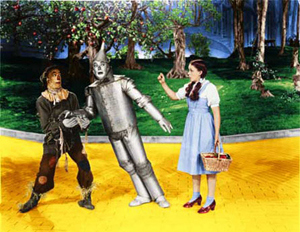THE WIZARD OF OZ

Screenshot from The Wizard of Oz (1939)
Rated sixth on the American Film Institute's list of the country's 100 greatest movies, The Wizard of Oz has become a defining feature of American culture. From its sepia-toned opening shots of Kansas to its Technicolor fantasy world of Oz, the 1939 Metro-Goldwyn-Mayer production permeates the American imagination with lines such as "Toto, I've a feeling we're not in Kansas anymore" and songs such as "We're Off to See the Wizard." The Cowardly Lion (Bert Lahr), the Scarecrow (Ray Bolger), the Tin Man (Jack Haley), and Dorothy Gale (Judy Garland) sang and danced their way into America's collective imagination in a script adapted from L. Frank Baum's book, with lyrics by E. Y. "Yip" Harburg and a score by Harold Arlen. In the process, Kansas and the Great Plains came to epitomize the drab and ordinary, the foil against which Oz and other parts of America, especially urban areas, seem fantastic and magical.
The Wizard of Oz opened in August 1939, a phenomenal year in movie history–Gone with the Wind, Wuthering Heights, Stagecoach, and Mr. Smith Goes to Washington also premiered that year. Nonetheless, The Wizard of Oz, directed by Victor Fleming, captured Academy Awards for best original score and best song ("Over the Rainbow"). Judy Garland also received a juvenile Oscar for her performance as Dorothy. Because the film played to large audiences of children, who did not pay full rates, the production did not make money until it was leased to television in 1956. Running each year on cbs or NBC, the show became standard family viewing fare.
Like the book before it, the film tells a uniquely American fairy tale, and in the new medium Americans related to it in greater numbers. At the same time, its audience broadened throughout the world, largely because, as author Salman Rushdie notes, the film actually improved on a good book, creating a work of art. An important aspect of this film transformation is the much larger role assigned to Kansas and its people. In Baum's book, only six pages in chapter 1 and under twenty lines in the final chapter are devoted to the sun-seared Great Plains. Only Auntie Em, Uncle Henry, Dorothy, and Toto appear. In contrast, the movie introduces three farmhands (played by Lahr, Bolger, and Haley), an itinerant salesman (Frank Morgan), and Miss Gulch (Margaret Hamilton). These characters mirror the most important characters in the Land of Oz. Introducing evil in the person of Miss Gulch and her counterpart, the Wicked Witch of the West, the film takes on an immediacy and drama not possible in the book. The Kansas sequence, shot in black and white and placed in a brown bath to mute the tones, emphasizes the stark difference between the reality of Kansas and the colorful fairyland of Oz.
Whether in Baum's book or the mgm movie, the sharp contrast between Kansas and Oz has always been a defining feature, suggesting that Oz is something more than it seems–a metaphor for America. In 1900, when the book was first published, America's economy was depressed, and Baum's Oz can be interpreted as a parody of America under the influence of the Populist party, which had arisen at the turn of the century to champion farmers and laborers against corporate America. In 1939 the country was in the depths of the Great Depression, and some viewers suggest that MGM's Oz might be a commentary on President Franklin D. Roosevelt's administration. In a 1981 interview in the Washington Post, songwriter Yip Harburg, who had considerable creative freedom on the film, claimed that the Emerald City represented the New Deal. Regardless of specific interpretations, however, both book and movie have lent themselves to political allusion, being recast in each new era. In the 1970s political pundits likened President Richard Nixon to the bogus Wizard of Oz caught behind the curtain in the movie, while illustrator Barry Moser modeled his wood engravings for a 1986 edition of the book on members of the Ronald Reagan White House. First Lady Nancy Reagan was identifiable as the Wicked Witch of the West.
No matter what the political interpretation, the 1939 film evokes a joyful, still innocent, can-do world in which each person already holds the solution to his or her own problems. In setting this up, however, The Wizard of Oz also creates a no-can-do Kansas, a dull drabness in the heart of America, making it one of the most controversial film portrayals of the Great Plains.
See also LITERARY TRADITIONS: Baum, Frank L. / POLITICS AND GOVERNMENT: Populists (People's Party).
Nancy Tystad Koupal South Dakota State Historical Society
Harmetz, Aljean. The Making of "The Wizard of Oz." New York: Alfred A. Knopf, 1977.
MacDonnell, Francis. "'The Emerald City Was the New Deal': E. Y. Harburg and The Wonderful Wizard of Oz." Journal of American Culture 13 (1990): 71–76.
Rushdie, Salman. The Wizard of Oz. BFI Film Classics. London: BFI Publishing, 1992.
Previous: Westerns | Contents | Next: Wyatt Earp Films
XML: egp.fil.065.xml
